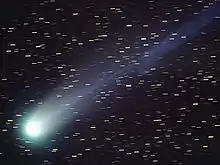| Discovery | |
|---|---|
| Discovered by | NEAT |
| Discovery date | March 15, 2002 |
| Designations | |
| P/2002 EX12 | |
| Orbital characteristics | |
| Epoch | 2022-08-09 (2459800.5) |
| Aphelion | 4.6014 AU |
| Perihelion | 0.60282 AU |
| Semi-major axis | 2.6021 AU |
| Eccentricity | 0.76833 |
| Orbital period | 4.1975 yr |
| Inclination | 11.2985° |
| Last perihelion | 2018 April 29[1] 2014 February 15[2] 2009 November 30 |
| Next perihelion | 2022-Jul-09[1] |
169/NEAT is a periodic comet in the Solar System. It is the parent body of the alpha Capricornids meteor shower in Late July. 169/NEAT may be related to comet P/2003 T12 (SOHO).[3] It comes to perihelion (closest approach to the Sun) on 9 July 2022.[1] On 13 July 2022 passed 0.1395 AU (20.87 million km) from Venus.[4] On 11 August 2026 it will pass 0.1672 AU (25.01 million km) from Earth and then come to perihelion on 21 September 2026.
169P is a low activity comet roughly a few kilometers in diameter.[5] 169P and the smaller body P/2003 T12 likely fragmented from a parent body roughly 2900 years ago.[5]
References
- 1 2 3 "169P/NEAT Orbit". Minor Planet Center. Retrieved 2014-06-02.
- ↑ Syuichi Nakano (2011-10-29). "169P/NEAT (NK 2135)". OAA Computing and Minor Planet Sections. Retrieved 2012-02-25.
- ↑ 169P NEAT and P/2003 T12 - 300 years ago
- ↑ "JPL Small-Body Database Browser: 169P/NEAT" (last observation: 2022-06-07). Jet Propulsion Laboratory. Retrieved 2022-06-22.
- 1 2 Sosa, Andrea; Fernández, Julio Angel; Fitzsimmons, Alan (2015). "Comets 169P/NEAT and P/2003 T12 (SOHO): Two possible fragments of a common ancestor?". American Astronomical Society. 29. Bibcode:2015IAUGA..2255583S.
External links
- Orbital simulation from JPL (Java) / Horizons Ephemeris
- 169P on Seiichi Yoshida's comet list
This article is issued from Wikipedia. The text is licensed under Creative Commons - Attribution - Sharealike. Additional terms may apply for the media files.

.png.webp)